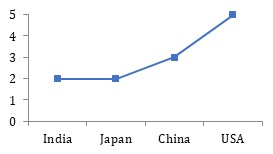PE 2 - Puzzles | LR - Puzzles
Join our Telegram Channel for CAT/MBA Preparation.
Answer the next 4 questions based on the information given below.
In Tokyo Olympics 2020 athletes from 4 different countries – USA, China, Japan and India won certain number of medals.
The graph below shows the number of athletes from each country.

Each athlete won either 1, 2, 3, 4, or 5 medals. The table below shows the distribution of athletes and number of medals.

No 2 athletes from a country won same number of medals.
If athletes from India win the maximum possible number of medals, what is the total number of medals won by all athletes from India?
Answer: 7
Workspace:
If it is known that China wins the maximum possible medals and maximum possible number of athletes got 4 medals, then how many athletes won 3 medals?
Answer: 2
Workspace:
In the previous question if minimum possible athletes won 2 medals, then how medals did athletes from Japan win?
- (a)
6
- (b)
5
- (c)
4
- (d)
Cannot be determined
Answer: Option B
Workspace:
What is the total number of medals that athletes from these 4 countries win?
- (a)
36
- (b)
35
- (c)
34
- (d)
Cannot be determined
Answer: Option D
Workspace:
Answer the next 4 questions based on the information given below.
Harappa was a tribe in the northwestern regions of South Asia. It heavily depended on trade of gold, silver, and bronze coins. Any member of the tribe could exchange coins amongst gold or silver or bronze for any of the other 2 types of coins. The coins are traded as a whole and can’t be cut for the purpose of exchange.
One gold coin can be exchanged for 2 silver and 2 bronze coins. 3 silver coins can be exchanged for 1 gold and 2 bronze coins.
One of the tribesman had certain number of coins with him. He exchanged one coin and ended up with same number of coins of each type. What is the minimum number of coins with him initially.
Answer: 3
Workspace:
One of the tribesmen had 3 gold, 5 silver and 8 bronze coins. He made some exchanges and ended up with least number of total coins. How many coins does he have now?
Answer: 7
Workspace:
One of the tribeswoman initially had 2 gold, 3 silver and 10 bronze coins. She went to the market to buy a dress for herself. She bought one of the 4 dresses that the shopkeeper had. Which dress she could have bought?
- (a)
Dress 1 costing 1 gold, 5 silver and 15 bronze coins
- (b)
Dress 2 costing 2 gold, 2 silver and 15 bronze coins
- (c)
Dress 3 costing 3 gold, 2 silver and 4 bronze coins
- (d)
Dress 4 costing 2 gold, 4 silver and 7 bronze coins
Answer: Option C
Workspace:
One of the children in the tribe had 3 gold, 4 silver and 14 bronze coins. He exchanged some of his coins such that he ends up with equal number of coins of each type. How many coins did he exchange?
Answer: 10
Workspace:
Answer the next 3 questions based on the information given below.
A die, with the numbers 1 to 6 marked on its six faces, was rolled 300 times and the number which turns up was noted down.
The table below gives the number of times that each individual number on the faces of the die turned up, in the first n rolls, where n = 50, 100, …, 300.

It was also observed that in no two consecutive rolls did the same number turn up.
If the number 6 turned up in the 150th roll, then which number/s could not have turned up in the 125th rolled?
- (a)
2
- (b)
1
- (c)
4
- (d)
3
Answer: Option B
Workspace:
Which of the following numbers must have turned up for the maximum number of times in the first 208 rolls?
- (a)
6
- (b)
5
- (c)
4
- (d)
1
Answer: Option A
Workspace:
Feedback
Help us build a Free and Comprehensive Preparation portal for various competitive exams by providing us your valuable feedback about Apti4All and how it can be improved.
 Solution
Solution Discuss
Discuss Report
Report